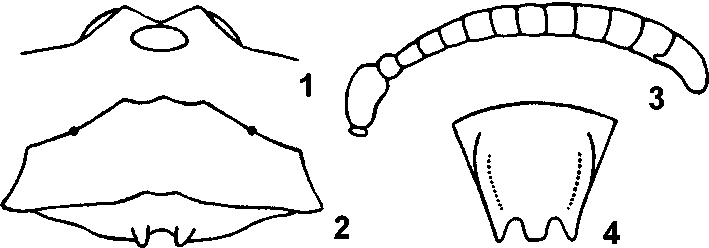![]() ZOOTAXA 641:
ZOOTAXA 641:
1-4-2004
(2004) www.mapress.com/zootaxa/
Copyright © 2004 Magnolia Press
ISSN 1175-5326 (print edition)
![]() ZOOTAXA
ZOOTAXA
ISSN 1175-5334 (online edition)
A new species of Brachystegm A. Costa (Hymenoptera: Crabronidae: Bembicinae) from Nepal
PAVEL G. NEMKOV
Institute of Biology and Soil Science, Russian Academy of Sciences, Vladivostok 690022, Russia nemkov® ibss. dvo. ru
Abstract
Brachystegus nikitini sp. nov. from Nepal is described and illustrated. This new species is similar to B. basalts (Smith), but differs in having a pair of subconical tubercles on the interocellar space, mostly red legs in the male (presumably also in the female) and unusual male sternal brushes of long erect setae joined at their tips.
Key words: Hymenoptera, Crabronidae, Bembicinae, Brachystegus, new species, Oriental
Introduction
Digger wasps of the genus Brachystegus inhabit the Palaearctic, Ethiopian and Oriental regions. Twenty species of this genus are known (Bohart & Menke 1976, Krombein 1985, Wu & Zhou 1991, Nemkov 2003), but a key to the all species is not available now. The natural history of Brachystegus wasps is poorly studied. Delaurence (1943) presented evidence that Brachystegus scalaris (Illiger) is a cleptoparasite of Tachytes panzeri (Dufour). Other species of this genus presumably are also parasites of the Tachytes nests.
Materials and methods
During study of the Dr. C. Schmid-Egger digger wasp collection a new Brachystegus species from Nepal was found.
Abbreviations (after Tsuneki 1971) used throughout the text are as follows: distance between eyes on level of anterior ocellus (IODo); distance between eyes on level of anten-nal socket (IODa); distance between eye and antennal socket (OAD); width of antennal distance between antennal sockets (/AD); distance between inner margin of eye and outer margin of hind ocellus (OOD); distance between inner margins of hind ocelli (POD); anterior ocellar diameter (Od); length to width ratio of antennal joint 3[13] (A3[13]L:W).
Brachystegus nikitini Nemkov, sp. nov. (Figs. 1-4)
Etymology. The species is dedicated to the famous Russian writer and amateur of entomology Mr. Yu. A. Nikitin.
Type material: Holotype, cf, NEPAL: Chitwan Distr., Sauraha, [27°34'N 82°29'E], 200m, 31.V-4.VI 1997 (Hauser) (Zoologische Staatsammlung, Muenchen, Germany).
Diagnosis. Brachystegus nikitini is a species apparently closely related to B. basalis (Smith) in having a similar body structure, punctuation and coloration, but it distinctly differs from the latter in having a pair of subconical tubercles on the interocellar space, mostly red legs in male (presumable also in female) and unusual male sternal brushes.

FIGURES
1-4. Brachystegus nikitini sp. nov., male. 1,
vertex, frontal view; 2, clypeus; 3, antenna; 4, tergum VII.
Description. MALE. Body length 7.5 mm. Clypeus weakly convex, with sharp transverse bend in low third; its anterior margin somewhat round, with two small teeth in middle (Fig. 2). OAD:WAS:IAD=W:9:5. Frons weakly convex. Inner eye margins distinctly diverging upward, slightly emarginated above middle. IODa:IODo=l.5. Frontal carina stout and obtuse, extending 0.4 of distance from antennal sockets to anterior ocellus. OOD:Od:POD=\8:8:\3. Space between anterior ocellus and hind ocelli with pair of distinct subconical tubercles (Fig. 1). Low occipital carina well-defined, joining hypostomal carina. Antennae nearly filiform, slightly thickened to apex; A3L:W=\.2, A12L:W=\.\, A13L:W=1.5; last joint somewhat curved downward, rounded apically (Fig. 3). Pronotum and shallow median sulcus. Gastral tergum VI posteriorly with a lateral carina that terminates in a backwardly directed tooth. Apical margin of tergum VII narrowly rounded out between lateral teeth so that apex appears tridentate (Fig. 4). Sterna II-V with apical brushes of long erected setae joined at their tips resembling triangular membranes. Body with short whitish setae, appressed and appreciably concealing integument on upper two thirds of clypeus, on lower half of frons, on posterolateral parts of dorsal propodeal surface and on gastral sternum II.
Upper half of frons, scutum, scutellum and mesopleuron contiguously pitted. Propo-deum longitudinally rugose dorsally, rather gently and irregularly reticulate posteriorly, finely and obliquely striate laterally. Gastral tergum I with moderately large subcontiguous punctures that become more separated posteriorly, interspaces with rather dense micro-punctures; punctuation of terga II-V becoming successively smaller and sparser; terga VI and VII coarsely contiguously punctured. Sternum II with scattered moderately large punctures and dense micropunctures from which the tomentum arises; sterna III-V semid-ull, without distinct punctures; sternum VI with moderately large contiguous punctures. Body black. Mandible reddish basally and black apically. Two small round spots on vertex behind and laterad of ocellar triangle, propodeal spines apically, oval posterolateral spots on terga I-IV (on I large, on II slightly smaller, on III and VI quite small) pale-yellow. Antenna black, last joint brownish beneath. All femora (except brownish basal half of forefemur), tibiae and tarsi red. Wings slightly infumated. Veins and stigma dark-brown.
FEMALE. Unknown.
Distribution. Nepal.
Natural History. No habitat information is provided on the holotype label.
Acknowledgments
I am very grateful to Dr. C. Schmid-Egger for the loan of specimens.
References
Bohart, R. M. & Menke, A.S. (1976) Sphecid Wasps of the World. A generic revision. University of California Press, Berkeley, Los Angeles, London. IX + 695 pp. Deleurance, E. Ph. (1943) Notes sur la biologic de quelques predateurs de la region de Montignac
(Dordogne). Bulletin du Museum d'Histoire Naturelle de Marseille, 3, 56-73. Krombein, K.V. (1985) Biosystematic studies of Ceylonese wasps, XV: a monograph of the Alyssoninae, Nyssoninae, and Gorytinae (Hymenoptera: Sphecoidea: Nyssonidae). Smithsonian Contributions to Zoology, 414, 1^2. Nemkov, P.O. (2003) Review of the digger wasps of the Genus Brachystegus A. Costa (Hymenoptera, Crabronidae, Bembicinae) of Russia and neighbouring countries. Far Eastern Entomologist, 131, 1-5.
Wu, Y. & Zhou, Q. (1991) A stady of Chinese Nyssonidae with descritpion of a new species (Hymenoptera: Sphecoidea: Nyssonidae). Acta Entomologica Sinica, 34, 364-366.
Accepted by J.B. Whitfield: 18 Aug. 2004; published: 13 Sept. 2004
ANEW BRACHYSTEGUS © 2004 Magnolia Press
NEMKOV